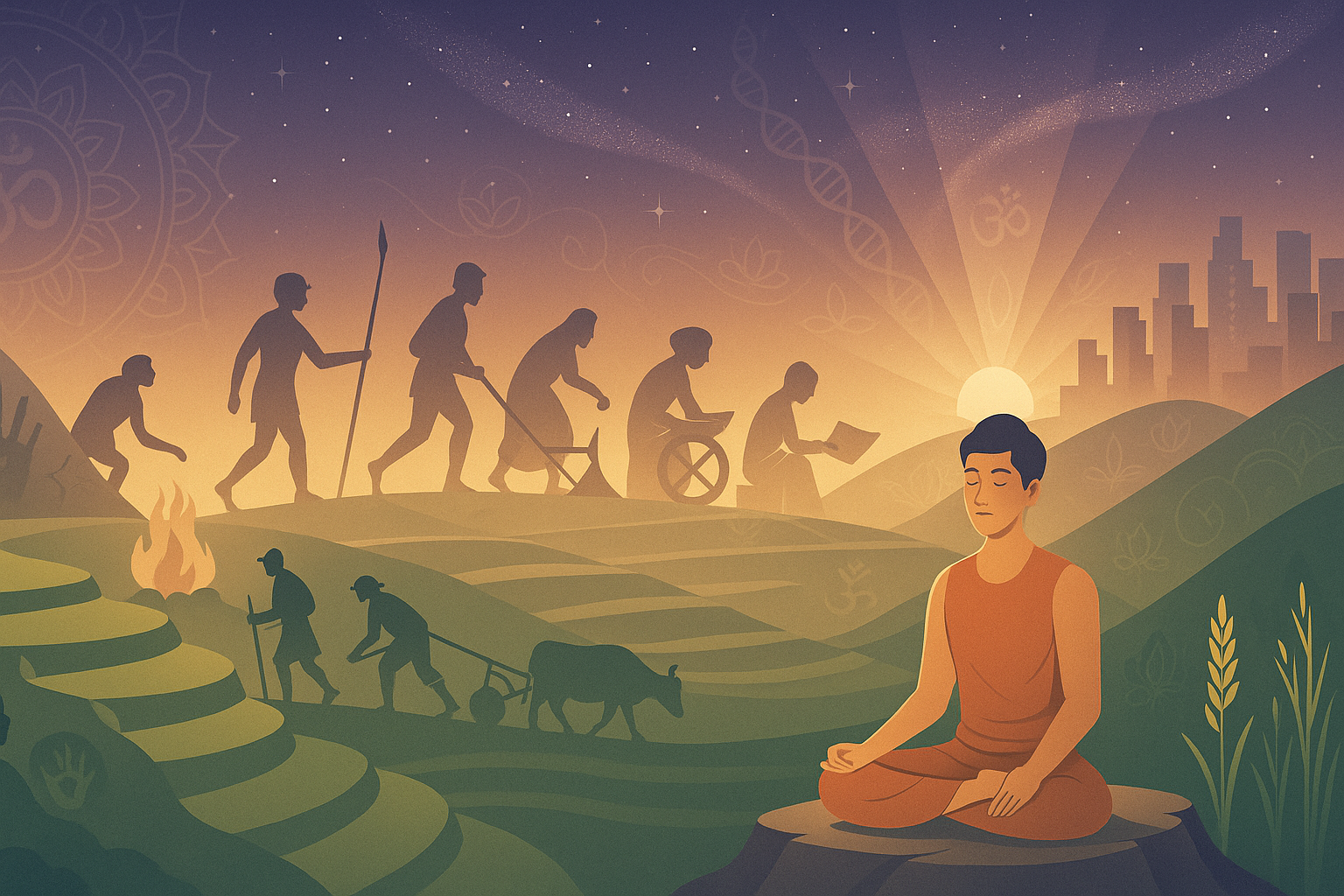Seeds, Stories, and the Sacred: How Human Evolution Births Religion — A Sanātana Lens
Why did some human groups build cities and scriptures while others stayed nomadic? Jared Diamond’s Guns, Germs and Steel argues that geography—our access to domesticable plants and animals—shaped surplus, population, specialization, and eventually organized religion as societies scaled. He sums it up simply: history diverged mainly because environments differed, not people’s innate abilities.
From Seeds to Cities: The “Outer” Story
As foraging bands settled, food surpluses enabled specialists—scribes, priests, administrators. Institutions emerged to coordinate large groups: writing, states, and temple systems. Religion, at this scale, offered shared meaning and cooperation—rules for living together and hope through uncertainty.
From Questions to Realization: The “Inner” Story
Sanātana Dharma pairs that outer narrative with an inner science of consciousness. The Ṛig-Veda’s Nāṣadīya Sūkta (10.129) invites humility before origins—refusing easy answers and welcoming inquiry. The Upaniṣads outline a practical pedagogy: śravaṇa (listening), manana (reflecting), nididhyāsana (meditation)—how knowledge ripens into wisdom. And the Gītā gives the temperament to learn: “śraddhāvān labhate jñānam”—with reverent trust, knowledge flowers.
Takeaway for youth: Information fills the mind; śraddhā and practice transform the person.
Scaling Society without Splitting the Self: Ādi Śaṅkara’s Synthesis
In a fractured landscape of sects, Ādi Śaṅkarācārya revived non-dual insight (advaita) while honoring diverse devotion. His pañcāyatana pūjā placed Śiva, Viṣṇu, Devī, Sūrya, and Gaṇeśa together—different paths, one summit—cooling sectarian heat and uniting society around the One. He wrote lucid commentaries on the prasthāna-traya (Upaniṣads, Gītā, Brahmasūtra) and accessible prakaraṇa texts so philosophy could be lived, sung, and shared.
Try this—the Beiing Spiritual way
- Study the pattern — Learn why geography mattered (Diamond), so you respect context and contingency.
- Practice the process — Adopt the Upaniṣadic triad daily: listen (10 minutes of śāstra), reflect (journal one question), meditate (sit in silence).
- Seek the guide — Information scales with tech; transformation scales with a guru. As we say often, a true teacher turns maps into a lived journey. “śraddhāvān labhate jñānam.”
Two Engines of Flourishing
Put together, Diamond’s realism about the world (seeds, cities, institutions) and the Vedic realism about the Self (silence, insight, compassion) form two engines: outer coordination and inner transformation. One stabilizes society; the other stabilizes the self. That’s where history meets Dharma—and where a new generation can walk with clarity.
References & Sources
- Diamond, Jared. Guns, Germs and Steel: The Fates of Human Societies. (Short quotations and ideas summarized.)
- Bhagavad Gītā 4.39 (śraddhāvān labhate jñānam); 4.7–4.8 (Dharma’s restoration).
- Ṛig-Veda 10.129 (Nāṣadīya Sūkta), Upaniṣads pedagogy (śravaṇa–manana–nididhyāsana).
- Beiing Spiritual research notes and scripts on Ādi Śaṅkarācārya and the role of the Guru in Sanātana Dharma.






प्रातिक्रिया दे